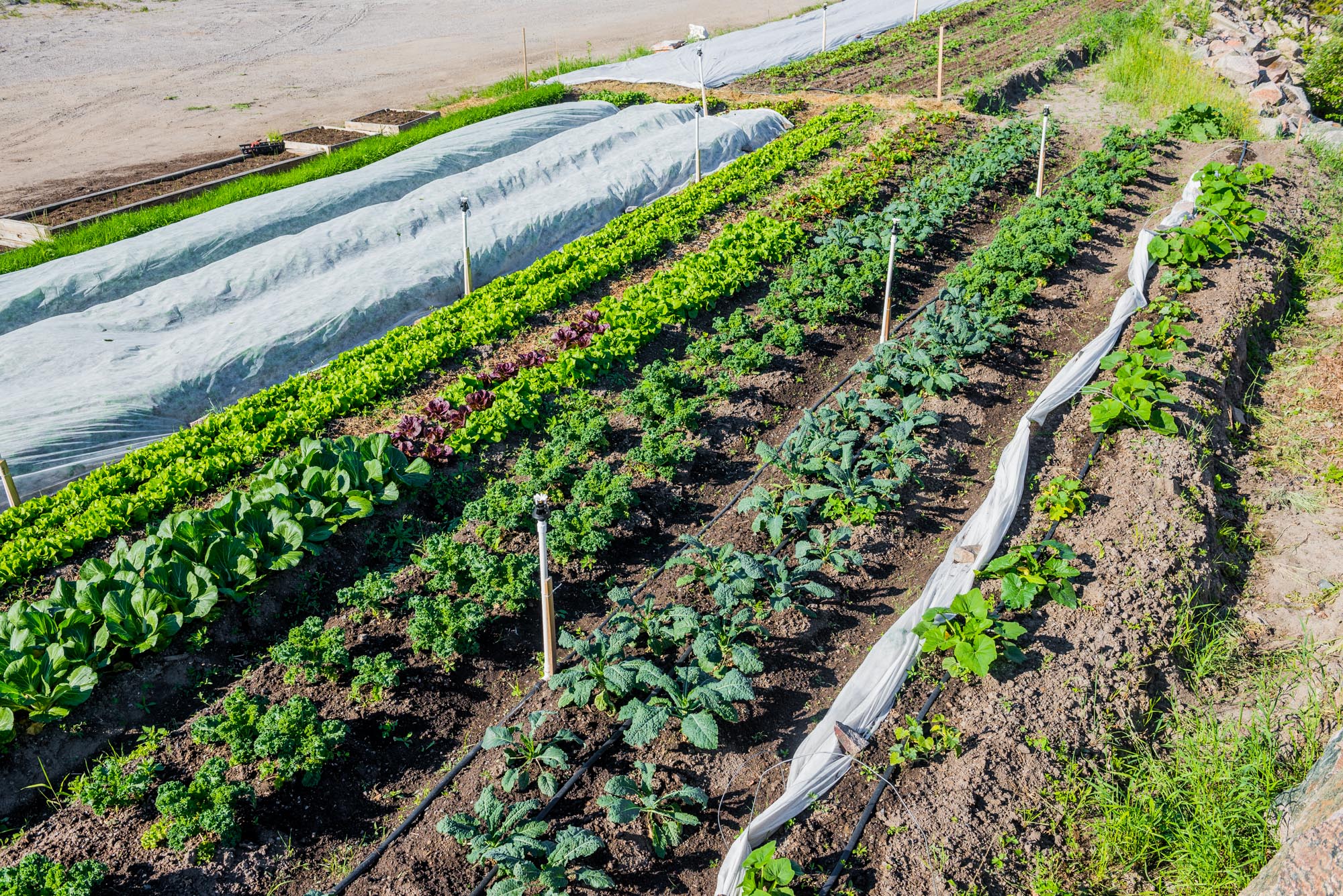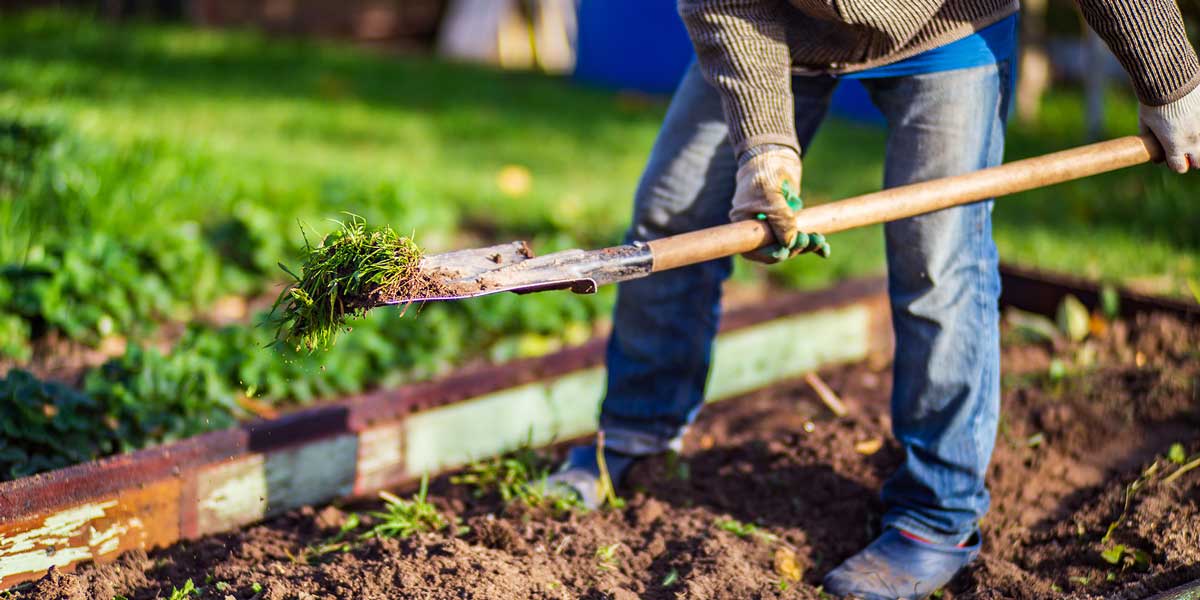

Articles
What Is A Market Garden
Modified: February 28, 2024
Discover the benefits and techniques of market gardening with our comprehensive guide. Enhance your gardening skills and grow your own sustainable and bountiful garden.
(Many of the links in this article redirect to a specific reviewed product. Your purchase of these products through affiliate links helps to generate commission for Storables.com, at no extra cost. Learn more)
Introduction
Gardening is a fulfilling and rewarding hobby that allows individuals to connect with nature and cultivate beautiful plants. However, beyond personal enjoyment, gardening can also be a means to contribute to a sustainable and self-sufficient lifestyle. One such approach is market gardening, which has gained popularity in recent years.
Market gardening refers to the practice of growing and selling fruits, vegetables, herbs, and flowers on a small-scale. Unlike conventional agriculture, market gardening focuses on maximizing productivity in a limited area, often utilizing organic and sustainable practices. By supplying locally grown produce, market gardens play a vital role in promoting food security, supporting the local economy, and reducing the carbon footprint associated with long-distance transportation.
Throughout history, market gardening has evolved and adapted to meet the changing needs and demands of communities. In this article, we will delve into the definition, history, characteristics, benefits, challenges, and sustainable practices associated with market gardening. Furthermore, we will explore the importance of market gardens in local food systems and provide examples of successful market gardens.
Whether you are a seasoned gardener looking to expand your knowledge or someone interested in sustainable food production, this article will serve as a comprehensive guide to the fascinating world of market gardening.
Key Takeaways:
- Market gardening is a small-scale, intensive approach to sustainable food production, offering fresh, nutritious produce, reducing food miles, and supporting local economies while promoting environmental stewardship and community engagement.
- Despite challenges such as land availability and market competition, market gardeners demonstrate resilience, creativity, and a commitment to sustainable practices, contributing to the well-being of individuals, communities, and the environment.
Read more: What Is Marketing In Construction
Definition of Market Garden
Market gardening, also known as truck farming or market farming, is a form of small-scale agriculture that focuses on producing high-value crops for direct sale to local markets. The term “market garden” originally referred to the cultivation of vegetables and herbs primarily for consumption in nearby towns or cities.
A market garden typically operates on a few acres of land and utilizes intensive cultivation techniques to maximize productivity. This type of gardening requires careful planning, efficient use of resources, and close attention to crop rotation, soil health, and pest management.
One distinguishing factor of market gardening is the emphasis on producing crops for immediate sale. This direct-to-consumer approach allows market gardeners to establish personal relationships with their customers and respond quickly to changing preferences and demands.
Market gardens often employ organic and sustainable practices, avoiding the use of synthetic fertilizers and pesticides. Instead, they focus on building healthy, fertile soils through composting, cover cropping, and crop rotation. Additionally, many market gardeners prioritize water conservation methods, such as drip irrigation or rainwater harvesting, to minimize environmental impact.
In recent years, the concept of market gardening has expanded to include not only vegetables and herbs but also fruits, flowers, and value-added products like preserves and artisanal goods. This diversification allows market gardeners to cater to a broader customer base and extend their growing season.
Overall, market gardening is a dynamic and adaptable practice that combines agricultural expertise, business acumen, and a deep connection to the local community. By producing fresh, nutritious, and sustainably grown food, market gardeners contribute to the health and well-being of both consumers and the environment.
History of Market Gardening
Market gardening has a rich history that dates back centuries. The origins of market gardening can be traced to ancient civilizations such as the Egyptians, Greeks, and Romans, who cultivated vegetables for trade and consumption in bustling city centers.
In medieval Europe, market gardening became an essential part of the feudal system. Peasants would grow vegetables on small plots of land, known as “burgage plots,” and sell their harvest at local markets. These gardens played a crucial role in providing fresh food to urban populations, particularly during times of scarcity.
During the 18th and 19th centuries, market gardening underwent significant transformations with the advent of urbanization and the rise of industrialization. As cities expanded, the demand for fresh produce increased, prompting farmers to specialize in growing market garden crops.
In the United States, market gardening grew in popularity during the 19th century. With the expansion of cities and the development of transportation networks, small-scale farmers were able to transport their goods to urban markets more efficiently. The growth of urban markets, such as Boston’s Haymarket Square and New York’s Union Square Market, provided valuable opportunities for market gardeners to sell their crops directly to consumers.
Advancements in agricultural technology and transportation further fueled the growth of market gardening in the 20th century. The introduction of greenhouses and irrigation systems allowed market gardeners to extend the growing season and cultivate delicate crops that were previously not viable in certain regions. Additionally, the use of refrigerated trucks and improved road networks facilitated the transportation of perishable produce over longer distances.
In recent decades, market gardening has experienced a resurgence due to increasing interest in local and sustainable food systems. Consumers are seeking out fresh, nutritious produce that is grown without harmful chemicals and transported over shorter distances. This shift in consumer preferences has created opportunities for small-scale farmers to establish thriving market gardens.
Today, market gardening is not only practiced in rural areas but also in urban and peri-urban settings. Urban agriculture initiatives, rooftop gardens, and community gardens are examples of how market gardening has adapted to meet the needs of urban dwellers who are eager to reconnect with the food they consume.
Overall, the history of market gardening reflects its ability to adapt and evolve with changing societal needs and demands. From providing sustenance to medieval populations to meeting the desires of today’s conscious consumers, market gardening continues to play a vital role in local food systems.
Characteristics of Market Gardens
Market gardens are distinguished by several key characteristics that differentiate them from traditional farming practices. These characteristics contribute to the efficiency, productivity, and sustainability of market gardens.
1. Size and Intensity: Market gardens are typically small-scale operations that focus on maximizing productivity in a limited area. Farmers utilize intensive cultivation techniques such as intercropping, succession planting, and raised beds to optimize space utilization and yield.
2. Crop Diversity: Market gardens often cultivate a wide variety of crops to cater to the diverse preferences of consumers. This diversity not only ensures a constant supply of fresh produce but also helps in managing pests and diseases through crop rotation and companion planting.
3. Direct Sales: A defining characteristic of market gardens is the direct relationship between the farmer and consumer. Market gardeners often sell their crops at farmers’ markets, community-supported agriculture (CSA) programs, or through on-site farm stands. This direct-to-consumer approach enables farmers to build personal connections, receive immediate feedback, and adapt their produce offerings accordingly.
4. Organic and Sustainable Practices: Many market gardeners prioritize organic and sustainable farming practices. They avoid synthetic fertilizers and pesticides, instead relying on composting, cover cropping, crop rotation, and natural pest control methods. These practices promote soil health, minimize environmental impact, and produce healthier and more flavorful produce.
5. Season Extension: Market gardeners often seek ways to extend the growing season, allowing them to offer fresh produce for longer periods. Techniques like using greenhouses, high tunnels, row covers, and cold frames enable farmers to protect crops from adverse weather conditions and provide favorable growing environments.
6. Efficient Water Management: Water conservation is a crucial aspect of market gardening. Farmers employ efficient irrigation systems such as drip irrigation or micro-sprinklers to minimize water waste and ensure targeted hydration for crops. Rainwater harvesting and water recycling systems are also commonly used to reduce reliance on freshwater sources.
7. Community Engagement: Market gardens frequently engage with the local community and foster a sense of food security and sustainability. By providing fresh, locally grown produce, market gardeners contribute to the overall well-being of the community, promote healthy eating habits, and support the local economy.
8. Continuous Learning: Market gardeners are often lifelong learners, constantly experimenting with new techniques and staying up-to-date with advances in sustainable farming practices. This willingness to adapt and grow ensures that market gardens remain innovative and resilient in the face of challenges.
In summary, market gardens are characterized by their small-scale, intensive nature, diverse crop selection, direct sales approach, focus on organic and sustainable practices, season extension methods, efficient water management, community engagement, and a commitment to continuous improvement. These characteristics contribute to the success and sustainability of market gardens as vital contributors to local food systems.
Benefits of Market Gardening
Market gardening offers a range of benefits that extend beyond the individual farmer or consumer. These benefits contribute to the overall sustainability, health, and resilience of local communities and ecosystems.
1. Access to Fresh, Nutritious Produce: Market gardens provide communities with access to fresh, locally grown produce. As the crops are harvested and sold quickly, consumers can enjoy fruits, vegetables, and herbs at their peak freshness, maximizing nutritional value and flavor. This accessibility to fresh produce promotes healthier eating habits and overall well-being.
2. Reduced Food Mileage: By supplying produce directly to local markets, market gardeners help reduce the carbon footprint associated with long-distance transportation. This reduction in food mileage contributes to a more sustainable food system by minimizing greenhouse gas emissions and reliance on fossil fuels.
3. Preservation of Agricultural Land: Market gardening often takes place on small plots of land that are well-suited for cultivation. By promoting the use of these smaller agricultural spaces, market gardens help preserve valuable farmland from urbanization and development, ensuring the continued availability of fertile land for food production.
4. Economic Stimulus: Market gardens have the potential to invigorate local economies. By selling directly to consumers or through community-supported agriculture programs, market gardeners keep a larger portion of the profits compared to traditional agricultural supply chains. This money circulates within the community, supporting local businesses and creating employment opportunities.
5. Environmental Stewardship: Market gardeners often prioritize organic and sustainable farming practices such as composting, crop rotation, and natural pest control methods. By minimizing the use of synthetic fertilizers and pesticides, they protect soil health, biodiversity, and water quality. This commitment to environmental stewardship helps to maintain ecological balance and reduce the negative impacts of agriculture on ecosystems.
6. Community Connection: Market gardens serve as gathering places where consumers can engage directly with farmers, fostering a sense of community and connection to the food they consume. This connection allows for a deeper understanding and appreciation of the hard work and dedication that goes into producing high-quality, locally grown food.
7. Food Security and Resilience: Market gardens play a vital role in enhancing local food security. By diversifying crop production and offering a wide range of products, market gardeners reduce the risk of supply chain disruptions and ensure a steady availability of fresh produce even during times of crisis or seasonal changes.
8. Educational Opportunities: Market gardens provide opportunities for learning and skill development. They serve as living classrooms where individuals can learn about sustainable farming practices, participate in community gardening initiatives, and gain knowledge about the importance of locally sourced, nutritious food.
Market gardening offers numerous benefits that contribute to the well-being of individuals, communities, and the environment. By supporting market gardens, consumers can make a positive impact on local food systems, promote sustainable practices, and enjoy the many rewards of fresh, flavorful produce.
A market garden is a small-scale farm that grows fruits, vegetables, and flowers for sale directly to consumers. It’s a great way to support local agriculture and access fresh, seasonal produce.
Challenges in Market Gardening
While market gardening offers numerous benefits, it also comes with its fair share of challenges. These challenges can pose obstacles to the profitability, sustainability, and success of market garden operations. It’s important for farmers to be aware of these challenges and develop strategies to overcome them.
1. Land Availability and Access: Finding suitable land for market gardening can be a significant challenge. With increasing urbanization and land development, access to affordable and appropriate-sized plots can be limited. Farmers may need to explore alternative options such as leasing land, participating in community gardens, or utilizing rooftop or vertical gardening techniques.
2. Intensive Labor Requirements: Market gardening is labor-intensive, requiring significant time and effort. From preparing the soil and planting to weeding, watering, and harvesting, the workload can be physically demanding. Farmers must carefully plan their time and resources to ensure efficient operations and avoid burnout.
3. Seasonality and Weather Risks: Market gardening often relies on favorable weather conditions for successful crop growth. Unpredictable weather patterns, extreme temperatures, frosts, droughts, and storms can impact crop productivity and quality. Farmers need to implement strategies such as crop diversification, protective structures like greenhouses or row covers, and water management techniques to mitigate the risks associated with weather variability.
4. Pest and Disease Management: Market gardens can be vulnerable to pests, diseases, and weeds. As market gardeners often prioritize organic practices, they may face limitations in terms of pest control options. Integrated pest management (IPM) techniques that rely on monitoring, biological controls, and cultural practices become crucial in maintaining healthy crops without relying heavily on synthetic chemicals.
5. Market Competition: Market gardening operates within a competitive space, with other local producers, farmers’ markets, grocery stores, and even online platforms vying for consumers’ attention. Market gardeners must differentiate their products through quality, variety, branding, and customer engagement to attract and retain customers.
6. Time and Financial Management: Running a market garden requires effective financial management to cover costs related to seeds, tools, equipment, land lease, marketing, and transportation. Farmers must carefully balance their budgets and plan for seasonal fluctuations in income. Additionally, market gardening demands time management skills to balance the demands of cultivation, harvesting, sales, and administrative tasks.
7. Knowledge and Skill Development: Successful market gardening relies on knowledge of horticulture, business management, marketing, and sustainable farming practices. Farmers must continuously upgrade their skills, stay informed about market trends, and adapt to changing consumer preferences. Seeking educational opportunities, attending workshops, joining farming networks, and staying connected to the agricultural community can help overcome knowledge gaps.
8. Scaling Up and Market Growth: As market gardeners aim to expand their operations to meet increased demand, they may face challenges in scaling up without compromising quality or sustainability. Scaling up may require additional investments in equipment, infrastructure, and labor. Strategically planning growth and considering the overall impact on sustainability and profitability is essential.
Despite the challenges, market gardening offers a rewarding and fulfilling experience. By approaching these challenges with creativity, adaptability, and resilience, farmers can overcome obstacles and build successful, sustainable market garden enterprises.
Sustainable Practices in Market Gardening
Market gardening, with its emphasis on local production and ecological stewardship, lends itself well to the implementation of sustainable practices. By adopting these practices, market gardeners can minimize their environmental impact, promote soil health, conserve resources, and create a more resilient and self-sufficient farming operation. Here are some key sustainable practices commonly employed in market gardening:
1. Organic Farming: Many market gardeners choose to follow organic farming practices, avoiding the use of synthetic fertilizers, pesticides, and genetically modified organisms. Instead, they focus on building and maintaining soil fertility through the use of compost, cover crops, and organic amendments. By working in harmony with nature, organic farming ensures the production of healthy and chemical-free produce.
2. Crop Rotation: Crop rotation is a sustainable practice that involves systematically planting different crops in rotation on the same plot of land. This technique helps to break pest and disease cycles, improve soil structure, and optimize nutrient utilization. By rotating crops, market gardeners can reduce the reliance on external inputs and maintain a balanced and resilient ecosystem.
3. Water Conservation: Market gardeners understand the importance of efficient water management. They employ water-conserving techniques such as drip irrigation, which delivers water directly to the plants’ root zones, minimizing evaporation and waste. Rainwater harvesting systems, such as rain barrels or collection ponds, are also commonly utilized to capture and utilize natural precipitation for irrigation purposes.
4. Soil Conservation and Improvement: Market gardeners prioritize soil health as the foundation for successful farming. They use practices such as cover cropping, which involves growing crops that protect and enrich the soil during periods of fallow or between cash crops. Cover crops help control erosion, build organic matter, fix nitrogen, and improve soil structure.
5. Composting: Composting is a sustainable practice widely used in market gardening. It involves collecting organic waste materials such as plant trimmings, kitchen scraps, and animal manure, and decomposing them into nutrient-rich compost. The resulting compost is then applied to the soil to enhance its fertility, structure, and microbial activity.
6. Biodiversity Enhancement: Market gardeners recognize the importance of biodiversity in maintaining a balanced and resilient ecosystem. They encourage biodiversity by incorporating companion planting techniques, creating habitat for beneficial insects and pollinators, and preserving natural areas within and around their farms. This approach helps to control pests naturally and promote ecological balance.
7. Energy Efficiency: Market gardeners seek energy-efficient approaches to minimize their carbon footprint. They prioritize energy-saving technologies such as using energy-efficient equipment, utilizing renewable energy sources, and optimizing farm layouts for maximum sun exposure and efficient use of space.
8. Waste Reduction and Recycling: Market gardeners implement strategies to reduce waste and recycle materials whenever possible. They minimize packaging waste by offering bulk produce options or using reusable containers. Additionally, they recycle plastic, glass, and other recyclable materials generated during farm operations.
9. Education and Outreach: Market gardeners actively engage in educating their communities about sustainable farming practices. They share their knowledge through workshops, farm tours, and community outreach programs to inspire others to adopt sustainable practices and foster a greater appreciation for local and sustainable agriculture.
By employing these sustainable practices, market gardeners can minimize their environmental impact, improve the resilience of their operations, and produce high-quality, healthy produce for their communities. Through their dedication to sustainability, market gardeners serve as leaders in creating a more sustainable and resilient food system.
Importance of Market Gardens in Local Food Systems
Market gardens play a vital role in the development of sustainable and resilient local food systems. They contribute to the economic, environmental, social, and health aspects of a community, fostering a secure and sustainable food supply. Here are several reasons why market gardens are important in local food systems:
1. Fresh and Nutritious Produce: Market gardens provide access to fresh, locally grown produce for communities. The short distance between the garden and the consumer ensures that fruits, vegetables, and herbs are harvested when they are at their peak flavor and nutritional value. This enhances the overall quality and taste of the food, supporting healthy eating habits and optimal nutrition for individuals.
2. Reduced Food Miles and Carbon Footprint: By supplying locally grown produce, market gardens help reduce the carbon footprint associated with long-distance transportation. The shorter distance food travels from farm to plate results in lower emissions of greenhouse gases. This reduction in food miles contributes to a more sustainable and environmentally friendly local food system.
3. Supporting Local Economy: Market gardens contribute to the local economy by creating employment opportunities and supporting small-scale farmers. They often sell their produce directly to consumers or through local farmers’ markets and community-supported agriculture (CSA) programs. The revenue generated from these sales circulates within the community, stimulating economic growth and supporting other local businesses.
4. Preserving Agricultural Land: Market gardens help preserve agricultural land from urbanization and development. By utilizing smaller plots of land efficiently, market gardeners promote the viability and importance of local farmland. This preservation ensures the availability of land for farming and contributes to the long-term sustainability of the local food system.
5. Enhancing Food Security and Resilience: Market gardens enhance food security by diversifying the local food supply. They offer a wide range of crops and varieties, reducing reliance on a limited number of commercially grown crops. Additionally, the practice of crop rotation and multiple plantings throughout the season helps to minimize the risks of crop failure due to pests, diseases, or adverse weather conditions. By fostering resilience, market gardens contribute to a more robust and secure local food system.
6. Engaging the Community: Market gardens serve as important community hubs where individuals can engage with local food production. By visiting farmers’ markets, participating in CSA programs, or getting involved in community gardens, consumers can establish a direct connection with the farmers and develop a deeper understanding of the food they consume. This engagement fosters a sense of community, strengthens social bonds, and promotes a culture of food knowledge and appreciation.
7. Promoting Sustainable Practices: Market gardens often prioritize organic, sustainable, and regenerative farming practices. By reducing the use of synthetic fertilizers and pesticides, employing efficient water management strategies, and focusing on soil conservation, market gardeners contribute to the overall health of the environment. These sustainable practices protect soil quality, conserve water resources, preserve biodiversity, and minimize the negative impacts of conventional agricultural practices.
Overall, market gardens hold immense importance in local food systems. They provide access to fresh, nutritious produce, support local economies, preserve agricultural land, enhance food security and resilience, engage communities, promote sustainable practices, and contribute to the overall well-being of individuals, communities, and the environment. By supporting and valuing market gardens, we can strengthen our local food systems and create a more sustainable and resilient future.
Examples of Successful Market Gardens
Across the world, there are numerous inspiring examples of successful market gardens that have made a significant impact on local food systems. These market gardens serve as models for sustainable farming and have demonstrated the potential for small-scale agriculture to thrive. Here are a few notable examples:
1. Singing Frogs Farm (California, United States): Singing Frogs Farm, located in Sebastopol, California, is a highly successful market garden known for its regenerative farming practices. By implementing techniques such as no-till farming, intensive cover cropping, and compost application, the farm has increased soil fertility, reduced water usage, and enhanced biodiversity. Singing Frogs Farm has been able to produce high yields of organic vegetables on just a few acres, demonstrating the potential for small-scale market gardens to be productive and sustainable.
2. La Ferme des Quatre-Temps (Quebec, Canada): La Ferme des Quatre-Temps, situated in Hemmingford, Quebec, is a 20-acre market garden operated by Les Jardins de la Grelinette. The farm focuses on bio-intensive farming methods, intensive planting, and efficient space utilization. With a strong emphasis on soil health and organic practices, La Ferme des Quatre-Temps has been able to cultivate a diverse array of vegetables and meet the demands of local consumers through farmers’ markets and their CSA program.
3. Market Garden at Green Connect (New South Wales, Australia): The market garden at Green Connect, located near Wollongong, New South Wales, is an inspiring example of a social enterprise market garden. Green Connect employs refugees and young people facing barriers to employment, providing training and employment opportunities in sustainable agriculture. The farm utilizes organic growing practices and offers a community-supported agriculture (CSA) program, supplying local consumers with fresh seasonal produce while also supporting sustainable employment and social inclusion.
4. Market Garden at Sarvodaya Farms (California, United States): Sarvodaya Farms, situated in Pomona, California, is a one-acre urban market garden that demonstrates the potential of farming in urban environments. Operating on leased land within a residential neighborhood, Sarvodaya Farms uses sustainable methods such as vermiculture, composting, and water-efficient irrigation systems. The farm not only supplies the local community with fresh produce through its CSA program but also provides educational opportunities for individuals interested in sustainable agriculture and urban farming.
5. La Ferme du Bec Hellouin (Normandy, France): La Ferme du Bec Hellouin, located in Upper Normandy, France, is a biodynamic market garden recognized for its high productivity and ecological practices. The farm emphasizes permaculture principles, biodiversity, and soil improvement techniques. La Ferme du Bec Hellouin showcases the potential for small-scale intensive farming to create a balanced ecosystem and optimize resource utilization while providing a wide variety of vegetables for local markets and their on-site farm shop.
These examples illustrate the diverse approaches and practices that can lead to successful market gardens. They showcase the potential for small-scale farming to contribute to local food systems, promote sustainability, and provide communities with fresh, locally grown produce. By learning from the experiences of these successful market gardens, more farmers and communities can be inspired to adopt innovative practices and create thriving and sustainable local food systems.
Conclusion
Market gardening holds great significance in the realm of sustainable food production and local food systems. From its historical roots to its present-day innovations, market gardens have evolved and adapted to meet the needs of communities while prioritizing environmental stewardship and community engagement.
Through their small-scale, intensive approach, market gardens offer numerous benefits. They provide access to fresh, nutritious produce for consumers, reduce food miles and carbon footprints, support local economies, preserve agricultural land, enhance food security and resilience, and promote sustainable farming practices. Market gardens play a critical role in creating a more sustainable and resilient food system, strengthening the connection between farmers and consumers, and fostering a sense of community.
However, market gardeners are not without their challenges. Land availability, labor intensity, seasonality, pests, market competition, financial management, and knowledge development can pose obstacles. Nevertheless, market gardeners tackle these challenges with creativity, determination, and a commitment to continuous improvement. By doing so, they demonstrate the potential for sustainable farming practices to thrive and contribute to the well-being of individuals, communities, and the environment.
As consumers, we can support market gardens by choosing to purchase locally grown produce, participating in farmers’ markets or CSA programs, and advocating for policies that promote and protect small-scale agriculture. By valuing market gardens and investing in sustainable, locally sourced food, we contribute to the resilience and vibrancy of our communities, promote a healthier food system, and protect the environment for future generations.
In conclusion, market gardens embody the essence of sustainable agriculture, connecting people to the land, fostering community, and harmonizing human needs with the environment. They offer a way for individuals and communities to cultivate not only nutritious food but also a deeper connection to the natural world. By embracing and supporting market gardens, we can create a more sustainable, resilient, and equitable food system for the benefit of all.
Frequently Asked Questions about What Is A Market Garden
Was this page helpful?
At Storables.com, we guarantee accurate and reliable information. Our content, validated by Expert Board Contributors, is crafted following stringent Editorial Policies. We're committed to providing you with well-researched, expert-backed insights for all your informational needs.














0 thoughts on “What Is A Market Garden”